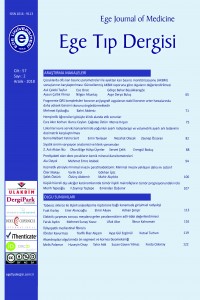Öz
Genetik olarak tanı konmuş 4 akondroplazi olgusunun Pentacam ile elde edilmiş ön segment bulguları ve Ocular Response Analyser ile elde edilmiş kornea biyomekanik özellikleri sunulmuştur. Fibroblast growth factor Receptor 3 (FGFR3) geninde p.G380R heterozigot fonksiyon kazanımı mutasyonu saptanan 4 olgu çalışmaya dahil edildi. Merkezi kornea kalınlığı bir hastanın iki gözünde normal değerlerden yüksek, korneal histerezis ve korneal rezistans faktörü iki hastanın üç gözünde eşlik eden yüksek göziçi değerleri ile normal değerlerden düşük bulundu. Sonuç olarak, FGFR3 etkilenmesinin akondroplazi hastalarında merkezi kornea kalınlığı, korneal histerezis ve korneal rezistans faktörü değerlerinde değişikliklere yol açabileceği öngörüldü.
Anahtar Kelimeler
FGFR3 Ocular Response Analyser pentacam. Akondroplazi genetik pentacam.
Kaynakça
- Vajo Z, Francomano CA, Wilkin DJ. The molecular and genetic basis of fibroblast growth factor receptor 3 disorders: The achondroplasia family of skeletal dysplasias, Muenke craniosynostosis, and Crouzon syndrome with acanthosis nigricans. Endocr Rev 2000;21(1):23-39.
- Shiang R, Thompson LM, Zhu Y-Z, et al. Mutations in the transmembrane domain of FGFR3 cause the most common genetic form of dwarfism, achondroplasia. Cell 1994;78(2):335-42.
- Al Mahmood AM, Al Katan HM, Al Bin Ali GY, Al-Swailem SA. Achondroplasia associated with bilateral keratoconus. Case Rep Ophthalmol Med 2012;2012:573045.
- Rabsilber TM, Khoramnia R, Auffarth GU. Anterior chamber measurements using Pentacam rotating Scheimpflug camera. J Cataract Refract Surg 2006;32(3):456-9.
- Shah S, Laiquzzaman M, Cunliffe I, Mantry S. The use of Reichert ocular response analyser to establish the relationship between ocular hysteresis, corneal resistance factor and central corneal thickness in normal eyes. Cont Lens Anterior Eye 2006;29(5):257-62.
- Robinson ML, Ohtaka-Maruyama C, Chan CC, et al. Dysregulation of ocular morphogenesis by lens specific expression of FGF-3/int-2 in transgenic mice. Dev Biol 1998;198(1):13-31.
- Pehlivan S, Özcan A, Okutman Ö, et al. Akondroplazi'de moleküler genetik analizler: Bir ön çalışma. Ege Pediatri Bülteni 2001;8(4):205-8.
- Takenaka H, Yasuno H, Kishimoto S. Immunolocalization of fibroblast growth factor receptors innormal and wounded human skin. Arch Dermatol Res 2002;294(7):331-8.
- Barkana Y, Gerber Y, Elbaz U, et al. Central corneal thickness measurement with the Pentacam Scheimpflug system, optical low-coherence reflectometry pachymeter, and ultrasound pachymetry. J Cataract Refract Surg 2005;31(9):1729-35.
- Kaushik S, Pandav SS, Banger A, Aggarwal K, Gupta A. Relationship between corneal biomechanical properties, central corneal thickness, and intraocular pressure across the spectrum of glaucoma. Am J Ophthalmol 2012;153(5):840-9.
Öz
Herein the anterior segment findings with Pentacam and corneal biomechanics with Ocular Response Analyser of 4 genetically proven cases of achondroplasia are reported. Four patients with heterozygous gain of function p.G380R mutation in fibroblast growth factor Receptor 3 (FGFR3) gene were evaluated. Central corneal thickness was higher than normal in both eyes of one patient, and corneal hysteresis and corneal resistance factor was lower in three eyes of two patients with accompanying high intraocular pressure readings. As a result, the affection of FGFR3 in achondroplasia patients might cause changes in central corneal thickness, corneal hysteresis and corneal resistance factor.
Anahtar Kelimeler
Achondroplasia FGFR3 genetics Ocular Response Analyser pentacam.
Kaynakça
- Vajo Z, Francomano CA, Wilkin DJ. The molecular and genetic basis of fibroblast growth factor receptor 3 disorders: The achondroplasia family of skeletal dysplasias, Muenke craniosynostosis, and Crouzon syndrome with acanthosis nigricans. Endocr Rev 2000;21(1):23-39.
- Shiang R, Thompson LM, Zhu Y-Z, et al. Mutations in the transmembrane domain of FGFR3 cause the most common genetic form of dwarfism, achondroplasia. Cell 1994;78(2):335-42.
- Al Mahmood AM, Al Katan HM, Al Bin Ali GY, Al-Swailem SA. Achondroplasia associated with bilateral keratoconus. Case Rep Ophthalmol Med 2012;2012:573045.
- Rabsilber TM, Khoramnia R, Auffarth GU. Anterior chamber measurements using Pentacam rotating Scheimpflug camera. J Cataract Refract Surg 2006;32(3):456-9.
- Shah S, Laiquzzaman M, Cunliffe I, Mantry S. The use of Reichert ocular response analyser to establish the relationship between ocular hysteresis, corneal resistance factor and central corneal thickness in normal eyes. Cont Lens Anterior Eye 2006;29(5):257-62.
- Robinson ML, Ohtaka-Maruyama C, Chan CC, et al. Dysregulation of ocular morphogenesis by lens specific expression of FGF-3/int-2 in transgenic mice. Dev Biol 1998;198(1):13-31.
- Pehlivan S, Özcan A, Okutman Ö, et al. Akondroplazi'de moleküler genetik analizler: Bir ön çalışma. Ege Pediatri Bülteni 2001;8(4):205-8.
- Takenaka H, Yasuno H, Kishimoto S. Immunolocalization of fibroblast growth factor receptors innormal and wounded human skin. Arch Dermatol Res 2002;294(7):331-8.
- Barkana Y, Gerber Y, Elbaz U, et al. Central corneal thickness measurement with the Pentacam Scheimpflug system, optical low-coherence reflectometry pachymeter, and ultrasound pachymetry. J Cataract Refract Surg 2005;31(9):1729-35.
- Kaushik S, Pandav SS, Banger A, Aggarwal K, Gupta A. Relationship between corneal biomechanical properties, central corneal thickness, and intraocular pressure across the spectrum of glaucoma. Am J Ophthalmol 2012;153(5):840-9.
Ayrıntılar
| Birincil Dil | İngilizce |
|---|---|
| Konular | Sağlık Kurumları Yönetimi |
| Bölüm | Olgu Sunumu |
| Yazarlar | |
| Yayımlanma Tarihi | 1 Haziran 2018 |
| Gönderilme Tarihi | 3 Nisan 2017 |
| Yayımlandığı Sayı | Yıl 2018 Cilt: 57 Sayı: 2 |
Ege Tıp Dergisi, makalelerin Atıf-Gayri Ticari-Aynı Lisansla Paylaş 4.0 Uluslararası (CC BY-NC-SA 4.0) lisansına uygun bir şekilde paylaşılmasına izin verir.

